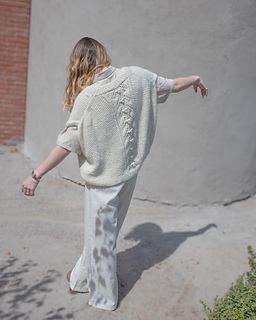patterns >  María Jesús Camus's Ravelry Store
María Jesús Camus's Ravelry Store
> Frappe Vest





























Frappe Vest
ENGLISH
This vest is an oversized garment that aims to be relaxed and give freedom of movement to the wearer, with dropped shoulders that simulate small sleeves, it is a perfect option to wear in mid-seasons or on spring evenings when the cold begins to appear.
It is worked top down and back and forth starting for the back neck and conitnuinhg with the back of the garment, making some increases to shape the armholes. Then stitches are picked up tu work the two fronts, also back and forth and making increases to shape the collar and armholes. Fronts and back are joined and worked in the roun to make the body of the piece, finishing with a 1x1 rib as a waistband, with a tubular bind-off. Stitches are picked up to knit the collar in 1x1 rib, who is also closed by used the tubular bind-off technique. Finally, stitches are picked from the armholes to work an i-cord edge. A lace motif is worked all the time on both the front and back of the garment. The lace motif is only charted.
DETAILS
Sizes: 1, 2, 3 (4, 5, 6) equivalent to 153, 160, 165 (178, 190, 202) cm of chest circumference (finished measurements, after blocking) with 50 - 70 cm of positive ease. Shown in size 2 in a body with 90 cm of chest circumference and 70 cm of positive ease.
Gauge: 13 sts and 22 rows = 10 cm, measured over seed stitch with larger needles, after blocking.
Yarn: About 520, 550, 600 (680, 780, 890) meters of DK weight yarn. Both samples are knitted with 2 fingering weight yarns and 1 lace weight mohair yarn, held together.
Needles:
5.0 mm circular needles with a cable of 80 cm
4.5 mm circular needles with a cable of 80 cm
5.0 mm circular needles with a cable of 40 cm (cuffs)
(Or needle sizes to get gauge)
Notions: Stitch markers, tapestry needle, stitch holders or scrap yarn, crochet hook (optional for bubbles), pins and mats for blocking.
ESPAÑOL
Este vest es una prenda oversize que busca ser relajada y brindar libertad de movimiento. Con hombros caídos que simulan mangas cortas, es una opción perfecta para usar en temporadas de transición o en las tardes de primavera cuando el frío empieza a aparecer.
Se teje de arriba hacia abajo y en plano, comenzando por el cuello trasero y continuando con la espalda, haciendo algunos aumentos para dar forma a las sisas. Luego, se recogen puntos para tejer los dos delanteros, también en plano, haciendo aumentos para dar forma al cuello y las sisas. Los delanteros y la espalda se unen y se tejen en redondo para formar el cuerpo de la pieza, terminando con un elástico 1x1 a modo de pretina, con cierre tubular. Se recogen puntos para tejer el cuello en elástico 1x1, que también se cierra con la técnica de cierre tubular. Finalmente, se recogen puntos de los agujeros de las mangas para tejer un borde de cordón o i-cord. Se teje un motivo de calados constantemente tanto en el delantero como en la espalda de la prenda. El motivo de encaje solo está graficado.
DETALLES
Tallas: 1, 2, 3 (4, 5, 6) equivalente a 153, 160, 165 (178, 190, 202) cm de circunferencia de pecho (medidas finales, post bloqueo) con 50 - 70 cm de holgura positiva. Mostrado en talla 2 en un cuerpo con 90 cm de circunferencia de pecho y 70 cm de holgura positiva.
Muestra: 13 p y 22 vtas = 10 cm, medido sobre punto arroz con las agujas más grndes, post bloqueo.
Hilado: Aproximadamente 520, 550, 600 (680, 780, 890) metros de hilado grosor DK. Las dos muestras están tejidas con 2 hebras de hilado grosor fingering y una hebra de groror lace (mohair), sostenidas juntas.
Agujas:
Agujas circulares de 5.0 mm con un cable de 80 cm.
Agujas circulares de 4.5 mm con un cable de 80 cm.
Agujas circulares de 5.0 mm con un cable de 40 cm.
(O el tamaño de aguja necesario para conseguir la muestra).
Otros: Marcadores de punto, aguja de lana, sostenedores de puntos o hilado de desecho, ganchillo (opcionl para bodoques) pines y mats de bloqueo.
- First published: March 2025
- Page created: March 28, 2025
- Last updated: March 28, 2025 …
- visits in the last 24 hours
- visitors right now




